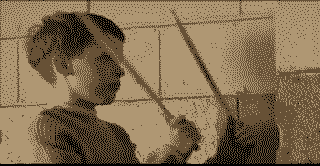Many a composers have walked these halls of hallucinations, guided by voices, consumed by musical madness, opened the doors of delusion, where everything disappears to man as it ain’t (still infinite), and beheard the sick psychedelic song at the center of the universe looping back in their mind’s ear, screaming like tinnitus and beating like bruits, humming like the homunculus in your head, or the brain-burrowing earworm who lays her catchy egg-songs and sinks her hooks into you, be it angelic air or demonic dirge, it eventually pollutes the conscious stream, disenchants the loom, and lest it consume them entirely and derail their train of thought, they set about lickety-quick in little black dots and white lines to denote the crazy chords and insane intervals that call out from beyond the yellow wallpaper, swarming the scores like silent spiders who peep back through the dark glassy eyes of God.
The most famous case of musical madness is found in Romantic composer Robert Schumann. He wrote in his diary about being constantly assaulted by a high A5. It’s possible his head tone was actually a chronic tinnitus, though it may have been another type of auditory hallucination related to his mental illness. Here’s a simulation of the note, that among other hauntings, drove Schumann mad.
Annoying aye? Schumann was also greeted by singing telegrams from the spirit realm. The ghosts of Mendelssohn and Schubert dictated a melody to him one crazy night, forgetting that he himself had composed it earlier, and wrote it into the Violin Concerto [1], which was left unplayed for a hundred years, until during a séance held by the grand-nieces of the violinist it was written for, the ghost of Robert Schumann appeared and ordered the work to be recovered from the Prussian State Library, and abiding world copyright laws, be performed, for the first time ever, in Germany.
Schumann attempted suicide by drowning himself in the Rhine, and when rescued jumped from the boat to drown himself again. He died soon after in an asylum.
Composers have to cool out sometimes, just to fend off the crazies. They gotta take a bath, or go play a game of Go. Maybe even make some love.
Whose the loneliest artist after all? The musician holds her instrument tight like a lover, and the painter falls for her own portrait. Writers have their wee fictional characters, sitting atop their shoulders at all times. But the composer is always alone, holed up inside their heads, moving melodies about, shifting rhythms around, structuring scraps of songs for years on end, singing to themselves like madmen and women.
Personal Aside:
These three black stemmed noteheads will make you mad. They whisper dark secrets about you. They are most certainly allying themselves with neighboring noteheads of other measures, and will eventually turn the whole score [2] against you. Their synesthesia makes you sick. Their sounding upon MIDI strings is like a cat organ, plucking catgut, vibrating in sympathy with the devil. Drag over if you dare!
And you ain’t the only one who thinks so. The flatted fifth interval between the E and Bb are known as a tritone, or ‘Diabolus in Musica’ (the Devil in Music). Schumann got off lucky, with his convenient Concert A tuned hallucination.
Yet you employ the unholy triad at every turn, in Japanese Insen, and Half-Whole keys. You flip two birds at their evil alliance, and play them forte, and often. You even listen to their hit songs like King Crimson’s “One More Red Nightmare” [3]. Because, just because…
Because, like the church composers always complain, “Why should the Devil have all the best tunes?”

Shine on crazy diamonds!
Notes:
[1] Violin Concerto, Schumann, Robert.
[2] “Bring Me To Supper”, Anima MIDI. (Crazies happen at 0:59.)
[3] “One More Red Nightmare”, King Crimson. (God-awesome.)




This sounds a bit like the opening of the Simpsons theme song?
Yeah Ted, you are correct. “The Simpsons Theme” is very similar to my 3 Tones of Madness. They are both in a Lydian Scale.
While the 3 tones go: Do, Mi, #Fa
The Simpsons goes: Do, #Fa, So
Thank you for drawing that to my attention!
And the first tones of the Simpsons theme melody go: Do Mi #Fa La So
Thanks Jimbo. I now see the connection Ted was making. •_•
I was mistakenly thinking of the melody where they sing “The Simpsons” and not the instrumental melody.
Very cool. Do you think the composer thinks to himself, “I’m going to write a song in the Lydian scale,” or is it not that planned and it just works out that way?
I think that Danny Elfman (the composer of “The Simpsons” and Tim Burton movies) often goes for a silly circusy sound, so certain scales appeal to him, like Lydian, because they are naturally silly sounding.
So in this case, I think the composer wakes up every morning, rolls up the shades, and says “I’m going to write another Lydian song!”